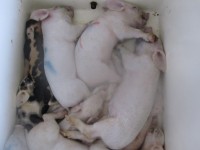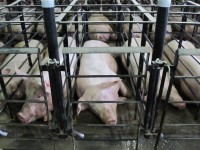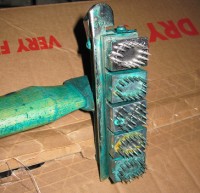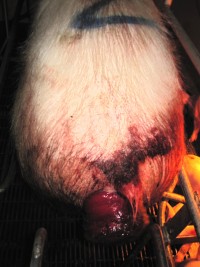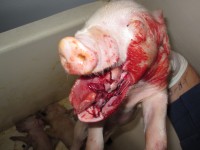 |
|
|
|
Day 1 Every day, the workers castrate and tail dock between 100 and 500 piglets. This is done by grabbing a piglet out of the crate by his leg, holding him upside down, slicing open his scrotum with a scalpel, and tearing out the testes with their bare hands. Tails are then docked by clipping them at the base with a dull set of pliers. The pigs struggle and squeal violently; it appears to be extremely painful, and no anesthesia is issued. Commonly during castration, a male pig's intestines will rupture, falling out of the incision. This is usually not immediately noticed, but when it is the pig is brought to the gas cart and suffocated to death. Pigs that are too small are brought to the "death cart." Pigs gather here throughout the day until there are enough to economically justify using the gas. A cracked and chipped cover is placed over the cart, and CO2 is pumped into the bin. My supervisor told me it's supposed to take 5 minutes, but usually takes 10, sometimes more. "It's incredibly cruel," she told me, "but it's how we're told to do it." Day 2 Today I went into the Gestation area. The sows are kept here for the vast majority of their lives. The crates are only 20" wide and about 75" long. Most of the sows are large enough that both of their sides touch the bars, allowing them absolutely no movement except a step forward or backwards. Many have deep sores on their shoulders and scrapes on their noses from constant rubbing against the metal bars. The floor is made of concrete, and covered in manure. Flies and fruit flies are everywhere. The smell is thick and oppressive. Many of the sows display neurotic behavior such as bar-biting and head-shaking. Day 8 My coworker handles the baby pigs with apparent contempt for their welfare, often taking amusement from shaking them or throwing them at their mothers. He picks them up by their ears and throws them at me, or carries them that way to the gas cart. One time today, he took one by the leg and casually flipped him up in the air over and over, the way a tennis player does with his racket. Day 10 Most of the sows here are very anxious for any stimulation. When I go to feed them, they stick their snouts through the area between the feeders and the bars, sniffing my hand and trying to work their way closer to me. They like being touched and petted. Day 11 At the end of the day, a medium-sized pig in the gas cart was still breathing. I told my supervisor, who told me that occasionally the gassing doesn't kill them, and that we should gas him again. Day 17 There was another dying pig lying in the hall today, gasping for air. My coworkers stepped around him and went into a room to continue working. When we finished and went back into the hall, a worker kicked the dying pig hard in the chest, and he flew back into the wall, leaving a trail of blood from his mouth. He continued to breathe as the workers walked away. Day 18 Before being moved from Gestation to Farrowing, sows are washed with a high-pressured hose. This equipment is not meant for use on live animals. Often, the workers end up cutting lines into their midsections, teats, feet and faces with the hot, high-pressured water. After this painful process, they are then soaked in an industrial detergent that causes them to furiously rub against the bars of their crates in discomfort. Day 21 I found an unusually large number of pigs that had been "laid on" today, which literally means they were caught between their mothers and the floors or walls of the crates. This is as tragic as it is common. It is obviously a very painful way to go. Day 22 Moving the sows from Gestation to Farrowing rooms can be difficult because the sows only get the chance to walk a handful of times a year. When they reach their destination and realize they are to enter another tiny crate, many resist, bucking and squealing and pushing their way past the workers, who force them in by pulling their ears and kicking them. One worker who was unloading baby pigs entertained himself by throwing them around in the air by their legs. Other times, he would hold them as high in the air as he could and let them drop, or forcefully dunk them into the bin of pigs. On one instance, he tried spinning a pig in midair towards the bin. It went flying, hit its back on the edge of the bin, and fell on the floor. "Don't let the animal rights people see that!" he declared. The workers continued to grab these pigs by their ears and legs and throw them into these bins until there were as many as 40 at a time, with them piled on top of each other. I was handed a ruptured pig and told to bring him to the gas cart. The cart was off but the lid was on. I opened it, and found about 15 dead pigs inside, and one who was still breathing but unconscious. This is the second time (out of very few instances that I've checked) that I've found a live pig after the gas has been run. Day 31 The sows are tattooed just above each leg with their serial numbers. To do this, a worker dips a large mallet with 3/4" long spikes at the end into ink, and then chases the sows around a group pen, whacking them with the spikes. The sows scream and run in avoidance. A gestation worker told me that she bolted two sows today. She said one took a long time to die, and walked around vomiting after being bolted. Day 32 The Gestation manager explained to me that the shock of being dropped from 24 lbs of feed a day (which they receive in Farrowing) to 5 lbs. (which they get in Gestation) serves to "shock" the sows' bodies into going back into heat. Ideally, he said, you can breed them immediately after they return from Farrowing. Day 43 Today, we gassed 17 pigs for being "non-viable," or not growing fast enough. At the end of the day, a female worker came back from bolting a sow looking exhausted. She told me that the sow couldn't use her back legs, but still managed to give her a lot of trouble. She kept dragging herself in the wrong direction, "squealing bloody murder," as she tried to lead the sow outside to bolt her. She said she was pushing the sow and yelling at her, and finally just said, "Goodbye, pig," and bolted her in the middle of the feed aisle. Day 44 Injecting the sows with drugs is about half of the workers' daily load. They are mostly antibiotics, penicillin, and steroids to keep them from succumbing to sickness. It's been very hot recently, which makes this facility dryer and dustier than ever. This must cause great discomfort to the pigs, who prefer cool, moist environments. This arid environment is not simply the result of carelessness on the corporation's part, however. We are repeatedly reminded never to allow the sows to get wet because, with their weakened immune systems, any water would breed a scourge of diseases. Day 45 At a company-wide meeting, a speaker for the Pork Quality Assurance program briefly mentioned our animal welfare guidelines, which she admitted were tricky. Sows are supposed to have enough room to lie down without touching another animal, the guidelines say, but as she said, "How can they lay down without touching another animal? Well, they can't. There's no crate in the world where they can lay down with their legs sticking out!" Day 52 In one room while I was treating pigs, I noticed a sow with a large rectal prolapse. I mentioned it to the other Farrowing workers, asking if I should write her up. "For what?" they asked.
They looked confused. "We don't treat that," one of them told me. "We'll let her wean her babies, if she makes it that long, then she's probably a goner." While doing vaccinations, one worker found a male pig that had ruptured, took him by his leg, and tossed him outside into the hallway, then resumed vaccinating. When we were finished, we found him near the dead bins. The worker rounded him up and grabbed him by his leg, then laconically walked down the halls, swinging him. When he turned into the gas cart room, he swung the pig lazily up into the air and slammed him into the wall, then tossed him into the cart, announcing, "Die honky!" and turning on the gas. I saw firsthand how clever and empathic pigs can be. A sow and her entire litter had escaped their crate and gathered in the hallway. I examined how they'd escaped and discovered that the sow had loosened steel pegs in two different places. I told a co-worker this story and she said that when a sow figures out how to unlock her crate, she often goes around unlocking all of the other crates as well. Day 54 The sow with the prolapsed rectum remains untreated, and the prolapse has started to decay, turn black, and smell. Day 59 Because her pigs are being weaned tomorrow, the workers bolted the sow with the rectal prolapse today. The Farm Manager came in with the bolt gun, looking frustrated. She said that she had just bolted a sow in Gestation, and had to bolt her four times before she died. When the workers bolted the prolapsed sow, she took two bolts. After the first, the sow became "mad as hell," as my coworker said, making it difficult to efficiently deliver the second one. Day 61 While throwing pigs - a common and very stressful practice I've described in earlier entries - my coworker told me that when he does this alone, he just throws the pigs right into the cart, from all the way across the crate. The tally of dead piglets for Monday - Friday this week is 145. Broken down, that's 71 laid-ons, 32 starve-outs, 16 runts, 10 ruptures, 9 poor quality, 3 deformed and 2 joint infections. Day 66 Today we had to bolt another sow with a rectal prolapse. One worker said that he was excited about this event. He told me that yesterday while driving with his family on the highway, he saw a groundhog running across the road, and prayed that it would come into his lane. When it did, he swerved and ran it over. "I just feel like killing something," he said. This was the second sow in as many weeks to develop a severe rectal prolapse. When he bolted her the first time, she didn't die. She just stood there looking stunned as blood trickled from her forehead. She then got her bearings and tried to turn and run. After a struggle, the worker got in another shot, which sent her down. She continued to spasm for another 15 minutes. When we returned, my supervisor told me she was dubbing my coworker "Two-Shot" in light of the fact he rarely kills the sow with one bolt. I found a pig with his snout and front teeth torn off and hanging by skin. He was still alive, and had clearly been like this for a while, since the blood had begun to scab. A worker pulled him out of the crate and gassed him with the other kill pigs. Day 67 Today, there was a dead sow in Farrowing. She had been "off feed" for the last two weeks, and appears to have starved to death. Last week, I had pointed out this sow to both my supervisor and the farm manager, who told me not to worry about her. As she became increasingly skinny and lethargic, I kept mentioning this sow to them, but they insisted she was fine. Now, she had either died of starvation or succumbed to whatever had caused her to stop eating. We dragged her emaciated body outside and later we dumped her in the compost pile. No testing was done. The gas cart was filled to the brim with pigs today, a total of 39, including 9 large pigs that were at weaning age. They were left in the cart all day to trample each other, before being gassed all at once. Day 73 After my supervisor asked me to turn off the gas in the gas cart, I did so, even though I could still hear rustling in the cart (According to our training manual, the ambient gas is supposed to kill them). Fifteen minutes later I checked the cart, and found that of about a dozen pigs, four were still breathing. Later that day, I mentioned this experience to my supervisor. A coworker said that she had the same experience earlier today. Any remaining illusions I had of this being a humane and efficient means of euthanasia are long gone. Video | Photo Gallery | Expert Statements | Investigator's Diary | Take Action |
 |

